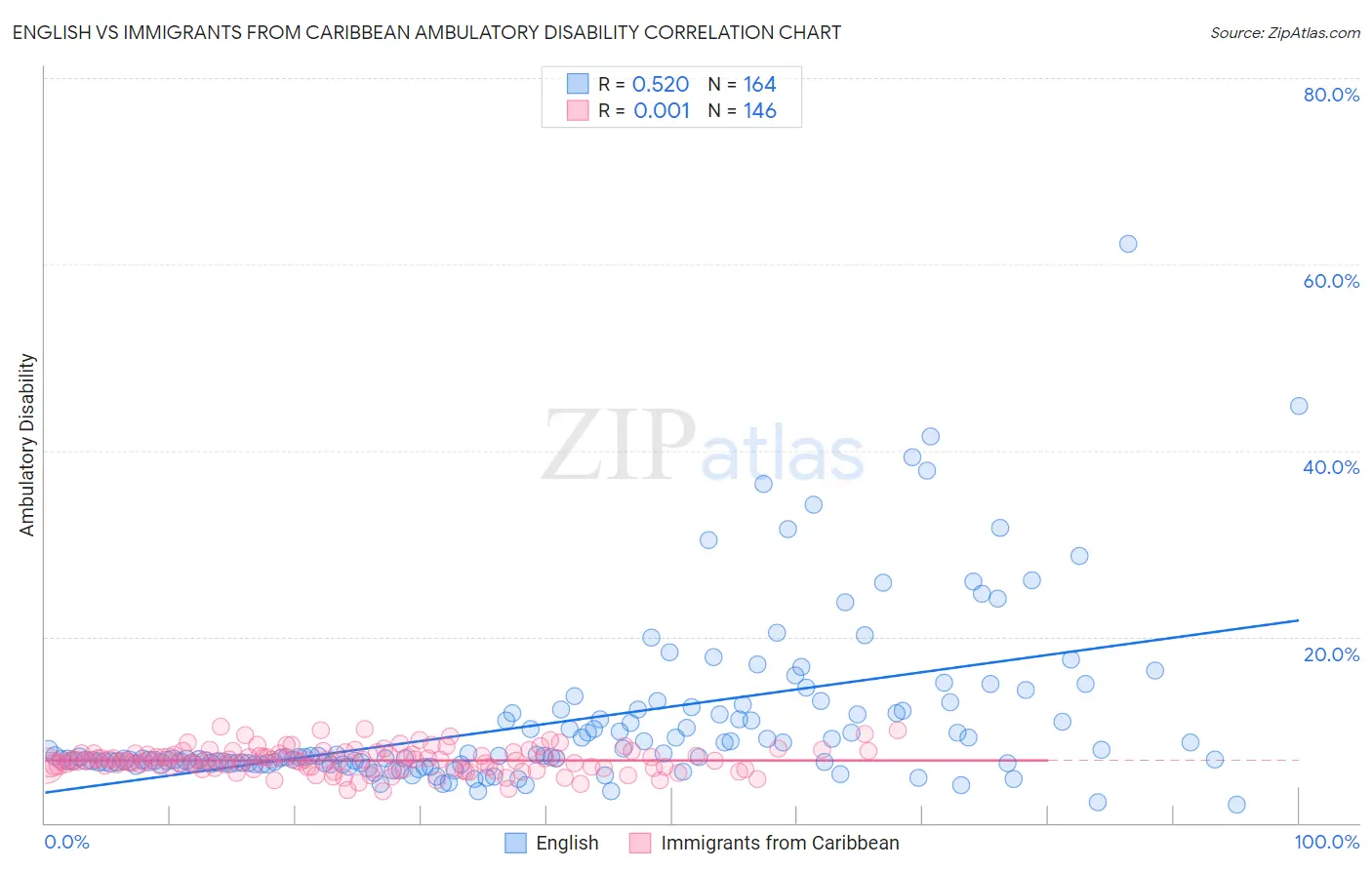English vs Immigrants from Caribbean Ambulatory Disability
COMPARE
English
Immigrants from Caribbean
Ambulatory Disability
Ambulatory Disability Comparison
English
Immigrants from Caribbean
6.6%
AMBULATORY DISABILITY
0.4/ 100
METRIC RATING
262nd/ 347
METRIC RANK
6.7%
AMBULATORY DISABILITY
0.0/ 100
METRIC RATING
279th/ 347
METRIC RANK
English vs Immigrants from Caribbean Ambulatory Disability Correlation Chart
The statistical analysis conducted on geographies consisting of 579,179,335 people shows a substantial positive correlation between the proportion of English and percentage of population with ambulatory disability in the United States with a correlation coefficient (R) of 0.520 and weighted average of 6.6%. Similarly, the statistical analysis conducted on geographies consisting of 449,814,526 people shows no correlation between the proportion of Immigrants from Caribbean and percentage of population with ambulatory disability in the United States with a correlation coefficient (R) of 0.001 and weighted average of 6.7%, a difference of 2.6%.

Ambulatory Disability Correlation Summary
| Measurement | English | Immigrants from Caribbean |
| Minimum | 2.0% | 3.4% |
| Maximum | 62.2% | 10.4% |
| Range | 60.2% | 7.0% |
| Mean | 11.0% | 6.7% |
| Median | 7.1% | 6.7% |
| Interquartile 25% (IQ1) | 6.4% | 6.0% |
| Interquartile 75% (IQ3) | 11.9% | 7.4% |
| Interquartile Range (IQR) | 5.5% | 1.4% |
| Standard Deviation (Sample) | 9.0% | 1.3% |
| Standard Deviation (Population) | 8.9% | 1.3% |
Demographics Similar to English and Immigrants from Caribbean by Ambulatory Disability
In terms of ambulatory disability, the demographic groups most similar to English are Hmong (6.6%, a difference of 0.12%), Irish (6.6%, a difference of 0.17%), Immigrants from Belize (6.6%, a difference of 0.24%), Nepalese (6.6%, a difference of 0.52%), and Bahamian (6.6%, a difference of 0.58%). Similarly, the demographic groups most similar to Immigrants from Caribbean are Pennsylvania German (6.8%, a difference of 0.10%), Immigrants from West Indies (6.7%, a difference of 0.31%), Jamaican (6.7%, a difference of 0.39%), Celtic (6.7%, a difference of 0.47%), and Immigrants from Guyana (6.7%, a difference of 0.50%).
| Demographics | Rating | Rank | Ambulatory Disability |
| Immigrants | Belize | 0.4 /100 | #260 | Tragic 6.6% |
| Irish | 0.4 /100 | #261 | Tragic 6.6% |
| English | 0.4 /100 | #262 | Tragic 6.6% |
| Hmong | 0.3 /100 | #263 | Tragic 6.6% |
| Nepalese | 0.2 /100 | #264 | Tragic 6.6% |
| Bahamians | 0.2 /100 | #265 | Tragic 6.6% |
| Guyanese | 0.2 /100 | #266 | Tragic 6.6% |
| Trinidadians and Tobagonians | 0.2 /100 | #267 | Tragic 6.6% |
| Spanish | 0.2 /100 | #268 | Tragic 6.6% |
| French | 0.1 /100 | #269 | Tragic 6.6% |
| Slovaks | 0.1 /100 | #270 | Tragic 6.7% |
| Immigrants | Trinidad and Tobago | 0.1 /100 | #271 | Tragic 6.7% |
| French Canadians | 0.1 /100 | #272 | Tragic 6.7% |
| Whites/Caucasians | 0.1 /100 | #273 | Tragic 6.7% |
| Sioux | 0.1 /100 | #274 | Tragic 6.7% |
| Immigrants | Guyana | 0.1 /100 | #275 | Tragic 6.7% |
| Celtics | 0.1 /100 | #276 | Tragic 6.7% |
| Jamaicans | 0.1 /100 | #277 | Tragic 6.7% |
| Immigrants | West Indies | 0.1 /100 | #278 | Tragic 6.7% |
| Immigrants | Caribbean | 0.0 /100 | #279 | Tragic 6.7% |
| Pennsylvania Germans | 0.0 /100 | #280 | Tragic 6.8% |